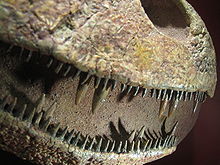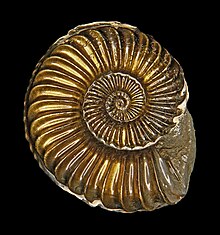The Devonian Portal
The Devonian (/dəˈvoʊni.ən, dɛ-/ də-VOH-nee-ən, deh-) is a geologic period and system of the Paleozoic era during the Phanerozoic eon, spanning 60.3 million years from the end of the preceding Silurian period at 419.2 million years ago (Ma), to the beginning of the succeeding Carboniferous period at 358.9 Ma. It is named after Devon, South West England, where rocks from this period were first studied.
The first significant evolutionary radiation of life on land occurred during the Devonian, as free-sporing land plants (pteridophytes) began to spread across dry land, forming extensive coal forests which covered the continents. By the middle of the Devonian, several groups of vascular plants had evolved leaves and true roots, and by the end of the period the first seed-bearing plants (pteridospermatophytes) appeared. This rapid evolution and colonization process, which had begun during the Silurian, is known as the Silurian-Devonian Terrestrial Revolution. The earliest land animals, predominantly arthropods such as myriapods, arachnids and hexapods, also became well-established early in this period, after beginning their colonization of land at least from the Ordovician period.
Fishes, especially jawed fish, reached substantial diversity during this time, leading the Devonian to often be dubbed the Age of Fishes. The armored placoderms began dominating almost every known aquatic environment. In the oceans, cartilaginous fishes such as primitive sharks became more numerous than in the Silurian and Late Ordovician. Tetrapodomorphs, which include the ancestors of all four-limbed vertebrates (i.e. tetrapods), began diverging from freshwater lobe-finned fish as their more robust and muscled pectoral and pelvic fins gradually evolved into forelimbs and hindlimbs, though they were not fully established for life on land until the Late Carboniferous. (Full article...)
Selected Devonian Article
The Marcellus Formation or the Marcellus Shale is a Middle Devonian age unit of sedimentary rock found in eastern North America. Named for a distinctive outcrop near the village of Marcellus, New York, in the United States, it extends throughout much of the Appalachian Basin.
The unit name usage by the U.S. Geological Survey (USGS) includes Marcellus Shale and Marcellus Formation. The term "Marcellus Shale" is the preferred name throughout most of the Appalachian region, although the term "Marcellus Formation" is also acceptable within the State of Pennsylvania. The unit was first described and named as the "Marcellus shales" by J. Hall in 1839. (Full article...)
List of selected Devonian articles
|
|---|
Selected Devonian land plant article
The rhyniophytes are a group of extinct early vascular plants that are considered to be similar to the genus Rhynia, found in the Early Devonian (around 419 to 393 million years ago). Sources vary in the name and rank used for this group, some treating it as the class Rhyniopsida, others as the subdivision Rhyniophytina or the division Rhyniophyta. The first definition of the group, under the name Rhyniophytina, was by Banks, since when there have been many redefinitions, including by Banks himself. "As a result, the Rhyniophytina have slowly dissolved into a heterogeneous collection of plants ... the group contains only one species on which all authors agree: the type species Rhynia gwynne-vaughanii". When defined very broadly, the group consists of plants with dichotomously branched, naked aerial axes ("stems") with terminal spore-bearing structures (sporangia). The rhyniophytes are considered to be stem group tracheophytes (vascular plants). (Full article...)
List of selected Devonian articles
|
|---|
Selected Devonian formation
The Rhinestreet Shale is a geologic formation in the Appalachian Basin. It dates back to the Devonian period. The Rhinestreet is an organic or Black Shale found on from the approximately the middle of the Appalachian Basin. Near the Middle of Ohio and Kentucky it reaches the surface on the flank of Cincinnati and Findlay Arches. (Full article...)
List of selected Devonian formation articles
|
|---|
Selected Devonian fish article
Tristichopterids (Tristichopteridae) were a diverse and successful group of fish-like tetrapodomorphs living throughout the Middle and Late Devonian. They first appeared in the Eifelian stage of the Middle Devonian. Within the group sizes ranged from a few tens of centimeters (Tristichopterus) to several meters (Hyneria and Eusthenodon).
Some tristichopterids share some of the features of the elpistostegalians, a diverse clade of tetrapodomorphs close to the origin of (and including) tetrapods.[better source needed] This mainly concerns the shape of the skull and a reduction in size of the posterior fins.
An old and persistent notion is that Eusthenopteron was able to crawl onto land using its fins. However, there is no evidence actually supporting this idea. All tristichopterids had become extinct by the end of the Late Devonian. (Full article...)
Selected Devonian invertebrate
Ammonoids are extinct spiral shelled cephalopods comprising the subclass Ammonoidea. They are more closely related to living coleoids (i.e., octopuses, squid and cuttlefish) than they are to shelled nautiloids (such as the living Nautilus). The earliest ammonoids appeared during the Devonian, with the last species vanishing during or soon after the Cretaceous–Paleogene extinction event. They are often called ammonites, which is most frequently used for members of the order Ammonitida, the only living group of ammonoids from the Jurassic up until their extinction.
Ammonites are excellent index fossils, and linking the rock layer in which a particular species or genus is found to specific geologic time periods is often possible. Their fossil shells usually take the form of planispirals, although some helically spiraled and nonspiraled forms (known as heteromorphs) have been found.
The name "ammonite", from which the scientific term is derived, was inspired by the spiral shape of their fossilized shells, which somewhat resemble tightly coiled rams' horns. Pliny the Elder (d. 79 AD near Pompeii) called fossils of these animals ammonis cornua ("horns of Ammon") because the Egyptian god Ammon (Amun) was typically depicted wearing rams' horns. Often, the name of an ammonite genus ends in -ceras, which is from κέρας (kéras) meaning "horn". (Full article...)
List of selected Devonian invertebrates articles
|
|---|
Need help?
Do you have a question about Devonian that you can't find the answer to?
Consider asking it at the Wikipedia reference desk.
Subcategories
Related portals
Associated Wikimedia
The following Wikimedia Foundation sister projects provide more on this subject:
-
Commons
Free media repository -
Wikibooks
Free textbooks and manuals -
Wikidata
Free knowledge base -
Wikinews
Free-content news -
Wikiquote
Collection of quotations -
Wikisource
Free-content library -
Wikiversity
Free learning tools -
Wiktionary
Dictionary and thesaurus


























